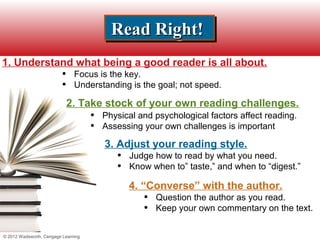
Chapter 9 reading
- 1. Read Right! Read Right! 1. Understand what being a good reader is all about. • Focus is the key. • Understanding is the goal; not speed. 2. Take stock of your own reading challenges. • Physical and psychological factors affect reading. • Assessing your own challenges is important 3. Adjust your reading style. • Judge how to read by what you need. • Know when to” taste,” and when to “digest.” 4. “Converse” with the author. • Question the author as you read. • Keep your own commentary on the text. © 2012 Wadsworth, Cengage Learning
- 2. Read Right! Read Right! 5. Dissect the text. • Cut up the text; try putting it into your own words. • Write ‘what’ and ‘why’ statements in the margins. 6. Make detailed notes. • Find the main points. • Write it down to help remember it later. 7. Put things into context. • Reading requires ‘cultural literacy.’ • Authors assume a common ground. © 2012 Wadsworth, Cengage Learning
- 3. Read Right! Read Right! 8. Don’t avoid the tough stuff. • Reading in college includes complicated sentences. • Reading aloud will help you work through difficult texts. • A common approach to reading is called SQ3R: • Survey: Skim to get the lay of the land quickly. • Question: Ask yourself what, why, and how questions. • Read (1): Read the entire assignment. • Recite (2): Put what you’re reading into your own words. • Review (3): Go back and summarize what you’ve learned. © 2012 Wadsworth, Cengage Learning
- 4. Read Right! Read Right! 9. Learn the language. • Every discipline has its own vocabulary. • Pay attention to the perspective and priorities of each discipline. 10. Bring your reading to class. • Instructors may use or refer to the text in class. • Bring up the reading in class and ask questions. 11. Ask for a demonstration. • Request mini-lessons on difficult class readings. • Bring up the reading in class and ask questions. 12. Be inventive! Parents should play an • Invent strategies that work for you! inestimable role in children’s • Make it applicable to your learning style. learning to read and learning to love to read. Barbara Swaby © 2012 Wadsworth, Cengage Learning
- 5. Meta-what? Meta-what? Metacognition, Reading and Studying Metacognition, Reading and Studying Meta = About Cognition = Thinking and Learning Metacognition = Thinking about Thinking and Learning about Learning Metacognition: • Knowing about yourself as a learner. • Identifying learning goals and progress. • Using your self-awareness to learn at your best. © 2012 Wadsworth, Cengage Learning
- 6. A Final Word About Studying A Final Word About Studying “Never regard study as a duty, but as the enviable opportunity to learn . . .” -Albert Einstein © 2012 Wadsworth, Cengage Learning
- 7. VARK Activity VARK Activity © 2012 Wadsworth, Cengage Learning p. 233